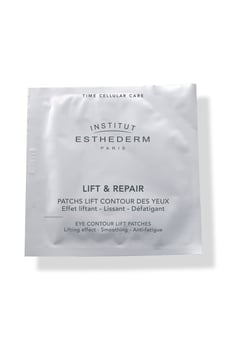LIFT & REPAIR PATCHS LIFT CONTOUR DES YEUX X10
INSTITUT ESTHEDERM

LIFT & REPAIR PATCHS LIFT CONTOUR DES YEUX X10
INSTITUT ESTHEDERM
LIFT & REPAIR PATCHS LIFT CONTOUR DES YEUX X10
Soin Contours des yeux
INSTITUT ESTHEDERM

INSTITUT ESTHEDERM
LIFT & REPAIR PATCHS LIFT CONTOUR DES YEUX X10
Soin Contours des yeux
Chacun de nos ingrédients ont été sélectionnés pour leur efficacité. Retrouvez tous les ingrédients de votre produit regroupés dans des familles en fonction de leur rôle.
Les ingrédients de nos formules ont été sélectionnés selon des critères dermatologiques très stricts et recommandés par des experts toxicologues indépendants. Classés dans trois grandes catégories d’actifs, vous découvrirez la nature, le rôle et l'origine de chacun en cliquant sur leur nom.
L’Eau Cellulaire contient / Cellular Water contains: AQUA/WATER/EAU, DISODIUM ADENOSINE TRIPHOSPHATE, CARNOSINE, MINERAL SALTS/SELS MINÉRAUX
Les ingrédients listés ici sont ceux contenus dans la dernière formule de ce produit. Un décalage de temps pouvant exister entre sa production et sa diffusion sur le marché, nous vous invitons à consulter la liste des ingrédients figurant sur l’emballage


Notre démarche de transparence
Bienvenue dans nos Laboratoires à Aix-en-Provence.
Découvrez notre approche scientifique unique, l’écobiologie.